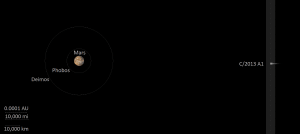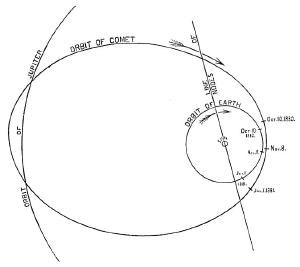Blog
Lost Comet
21 October 2014
 Wikipedia user Exoplanetaryscience
Wikipedia user ExoplanetaryscienceThis week comet Siding Spring (also known as C/2013 A1) made a close approach to Mars. It’s not a particularly bright comet, but it was close enough for the Opportunity rover to take an image of it from the martian surface. Think on that one just a bit. We have robots on Mars doing comet photography now. At closest approach, Siding Spring was about 140,000 km from the center of Mars. If it had made a similar pass by Earth it would have been about half the distance to the Moon.
In recorded history, we’ve never had a comet pass so close to Earth. We’ve had bright comets, and Earth even passed through the tail of Halley’s comet in 1910, but never a really close approach. The closest recorded comet flyby occurred in 1770 by Comet Lexell. It was discovered by Charles Messier just a month before close approach, and came within 2.2 million kilometers of our planet. At it’s closest, it was noted that the nucleus had an apparent size equal to Jupiter, and its coma was larger than the Moon.
 Popular Science Monthly (1881)
Popular Science Monthly (1881)The comet was named after Anders Johan Lexell, who determined its orbit and demonstrated that it was a periodic comet with a period of about 5.5 years. This meant its aphelion (greatest distance from the Sun) was in the region of Jupiter’s orbit. Although it was expected to return in 1776, it was never seen again. In the 1840s Urbain Le Verrier (famous for predicting the existence of Neptune) calculated that the comet made a couple close approaches to Jupiter that radically changed its orbit, possibly even throwing it out of the solar system.
Comet Lexell is now designated a lost comet. Siding Spring will soon head to the outer edge of the solar system, not to return to the inner solar system for a million years.